PRAFACE
INTRODUCTION
Herein you will find a simple introduction to the language of
the Yeti people. It is meant to give you a solid foundation upon which to build
vocabulary and be able to read in the native written language and construct
basic sentences. Hopefully at the end of this guide you will be able to hold
simple conversations and by able to speak about yourself and ask questions. This
introduction will provide you with some background on our language as well as
some notes on the structure and contents of this guide.
On Structure:
This guide is comprised of six units, each with 2-3 lessons
within them. Each lesson will introduce a specific grammatical component or
focus on a set of vocabulary with a central theme. There will be two exercises
per lesson to help you grasp the material covered. Additionally, there will be
a more difficult exercise at the end of each unit for further practice and
cumulative review.
There are two examinations: one at the mid-way mark and one at the
end. Each of these will be cumulative. This is a self-motivated guide, so there
is no requirement to do any of the exercises, though they will help you become
comfortable with the language.
There will be four ways new language will be introduced to you:
vocabulary sets, grammar, important phrases, and verb conjugations.
Vocabulary sets will be shown in a blue box.
Grammar is indicated by a green box.
Verbs and Conjugations will be shown in a red
box.
Important phrases will be in a yellow box.
Cultural remarks will be in indicated by a purple
box*.
*(These are not necessary to know but they do enhance the
experience by providing background and context. You may skip these if you don’t
care, I promise I will only be slightly offended.)
On Orthography and pronunciation:
For common letters which orthographically translate to
multiple sounds, we need a way to distinguish one sound from another. For these
letters, a circumflex (Û) will be used to mark soft sounds (consonant or
vowel), in orthographic translation, to make it easier to see the
distinction without native characters. An umlaut (Ü) will be used to indicate
accented hard vowels*. There will be a table that elaborates on this in Lesson
1. Orthographic translation allows the language to be used without use of
native characters, though I strongly recommend you do not rely solely on the
orthographic transcriptions, since most texts and signs in Titania only use
native script.
When introducing new vocabulary there will be a
standard format to make pronunciation easier. Periods in between words
demonstrate how a word is broken up syllabically. Capital letters will show
stressed syllables, for example, let's look at a word in the common
language you are likely already familiar with:

*Except for the hard A, which will be denoted by an ‘AA’ instead
of an umlaut to be consistent with the common methods of translating. See chart
in Unit 1 for details.
On Dialect:
For
the purposes of this guide, we will use the modern Titanian dialect. There are many
dialects, depending on regional and ancestral background, however, this is the
most common and wide-spread. Modern Titanian is the standard dialect taught in
schools, both in Titania and elsewhere. Since this is an introductory guide, it
will not expand upon other dialects. However, if you are curious about the
variations in some common phrases, see Appendix II.
Course Objectives
The goal of
this guide is to provide a practical knowledge base for anyone who wants to
converse in Titanian. I hope that by the end of this course, you will be able
to:
· Read
and write using the native alphabet
· Know
basic grammatical rules and how to structure a sentence.
· Introduce
and describe yourself and others and tell someone what you like or dislike
· Speak
about events or activities in the present and past tense
· Ask
and answer questions and give directions
· Express
opinions and compare things
· Conjugate
several types of regular verbs
PREFACE
A BRIEF HISTORY OF THE LANGUAGE
The language spoken in Titania descends from a proto-language spoken about 40,000 years ago. This was long before written records, however it is believed that the rudimentary language was common between ancient Yeti and Vibranni civilizations. As civilizations advanced, and the Yeti became increasingly isolated in the north, new distinct languages would evolve, though they share the same roots.
The proto-Yeti language that included a written component is thought to have evolved about 15,000 years ago among the small civilizations closest to the coast and mountainous regions of the north. A number of inscriptions have been found carved on loose objects. Most of these inscriptions are trade records and memorials to the dead while others, carved into stones, seemed to have been used in very old forms of folk magic. They are the oldest written records in Yeti history, and would eventually evolve into a stable set of over sixty runic symbols known now as the Aaldrsten.
This runic script was simplified in the 7th century, and inscriptions became more abundant. There was a large increase in nomadic Yeti during this time, as more began to brave the harsh inland conditions farther north. This simple and uniform set of twenty-three runes, the Ÿngrsten, became wide-spread and perhaps the first consistent written language among the ancient groups of Yeti peoples.
When international trade became more prevalent, particularly with the human civilizations, it brought along a strong influence from the language of humans. Most notably the common language inspired another revision of the runic writing system, one which created a concrete link between the written language and spoken dialects of the land. In the 13th century, a new twenty-two symbol runic alphabet system was created with each symbol assigned a specific phonetic correspondence. There have been stylistic changes to certain characters, however this is essentially the same system used today.
Titanian language forms a dialect continuum of more or less mutually intelligible local and regional variants. While the universally accepted alphabet provides standards for how to write, for much of history there was no officially sanctioned spoken language. Due to the vast size of Titania, there are numerous variations of the spoken language, all distinct though similar enough to be understood in almost any part of the country. In the 1758, the Council of Elders determined that the dialect spoken in the southeastern part of the country would be the standard used in Hjem, the political capitol, as well as the official dialect taught in schools. However, the use of any Titanian dialect is culturally accepted as correct spoken Titanian, and will likely be understood in any part of the country.
UNIT ONE
LESSON ONE: ALPHABET & PHONETICS
Alphabet – Native Characters:
The alphabet
has twenty-two different runic characters. Some of these characters represent
multiple sounds, which are denoted by a single dot or a crescent above the
character. Details about each of these diacritical marks and what they
represent will be discussed later in the lesson.
The diagram
below shows each distinct character as well as the possible marking (and sound)
it can represent. Please note that the markings are combined here for brevity,
but in actual usage a letter will never be distinguished by both a dot and
crescent at the same time.
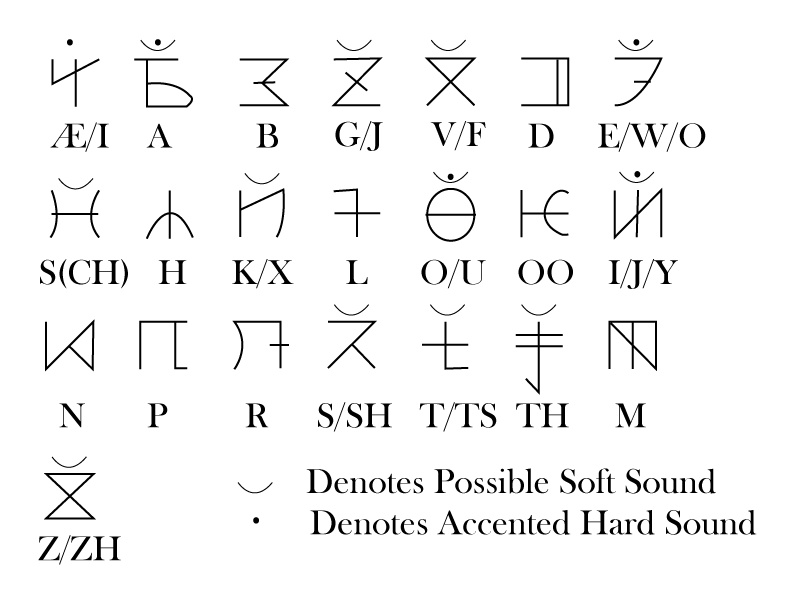
If you would like to learn more about the
origins of the Titanian alphabet and how it has developed throughout history,
refer to the Introductory section, under A Brief History of the Yeti Language.
Orthography
and Pronunciation:
*(H,A,S): H=hard sound, no accent ; A = hard sound w/ accent; S = soft
sound
|
Character
|
Orthographic symbol
|
Sound
(H,A,S)/(H,S)*
|
English example
|
IPA symbol
|
|
A
O
a
|
A,
AA
Â
|
“Ah” ,
“Aw”,
“A” (short)
|
Cat,
Talk,
Acorn
|
æ
ɑ:
eə
|
|
I
i
|
Æ,
Ï
|
“Ay” (long),
“Aye”
|
May
Ice
|
eɪ
aɪ
|
|
B
|
B
|
B
|
Balloon
|
b
|
|
G
J
|
G,
DJ
|
G,
J
|
Game,
Joy
|
g
dʒ
|
|
E
e
W
|
E,
U,Ë
W
|
È,
“Uh”,
W
|
Get,
Up,
Window
|
e
ʌ, ë
w
|
|
V
F
|
V,
F
|
V,
F
|
Vet,
Farm
|
v
f
|
|
d
|
D
|
D
|
Dog
|
d
|
|
C
c
|
CH,
SK
|
“tsh”,
“Sk”
|
Chair,
School
|
ʈʃ
s + k
|
|
h
|
H
|
H
|
House
|
h
|
|
K
k
|
K,
X
|
K
“ks”
|
Kite
Extra
|
K
k + s
|
|
l
|
L
|
L
|
Lake
|
l
|
|
o
U
u
|
O,
Ü,
Û
|
“Oh”
“Oo”/“eu” **
“Yu”
|
Open,
Über, Boot
Unicycle
|
əʊ
ü, u:
j + u:
|
|
q
|
OO
|
“Oo” (short)
|
Book
|
ʊ
|
|
m
|
M
|
M
|
Music
|
m
|
|
n
|
N
|
N
|
New
|
n
|
|
p
|
P
|
P
|
Park
|
p
|
|
r
|
R
|
“Rrr”
|
Red
|
r
|
|
S
s
|
S,
SH
|
“Sss”
“Sh”
|
Stop,
Shake
|
s
ʃ
|
|
T
t
|
T,
TS
|
T
“ts”
|
Top,
Let’s
|
t
t͡s
|
|
X
x
|
TH
TH
|
Th (voiced),
Th
(unvoiced)
|
This,
Think
|
ð
θ
|
|
Y
y
j
|
Y,
I,Ÿ
Ĵ
|
“Ee”
“ih”
Y
|
Key,
In
Yolk
|
i:
ɪ
j
|
|
Z
z
|
Z,
J
|
“Zz”,
“Zh”
|
Zoo,
Beige
|
z
ʒ
|
** More accurately, this sound is a combination of the two
examples provided, but as it does not exist as part of Common language, and
because spoken variations are abundant even from person to person, it is
considered to be correctly pronounced using either sound or a combination of
the two.
Lesson
1.1: Alphabet Practice
Practice
writing each letter so you can get used to the written form of the language. It
might seem trivial, but it will be much easier to work on later lessons when you
do not need a reference to know what the letters are, what they sound like, and
how to write them.
Hard
and Soft Sounds:
Each letter is broken into hard, or ‘voiced’, sounds and soft,
or ‘unvoiced’, sounds. Hard consonants typically require the throat and
vibration of/near lips to make the sounds, whereas soft consonants more use the
teeth and pushing air past the lips.
·
Hard sounds encompass consonant sounds such as ‘v’,’g’,’th’
(as in the), and ‘k’ sounds.
·
Their soft counterparts consist of the ‘f’,
‘j’,’g’,’th’ (thick), and ‘s’ sounds. Soft sounds are designated by a [ ˘ ] symbol using
the native alphabet.
Accented v. Non-Accented Vowels:
Hard vowel
sounds can also have two different sounds, differentiated by accent. Accented
vowels are orthographically denoted in text by the umlaut (¨) symbol and in native characters using a single dot above the
letter (˙).
The general pattern is that accented vowel
sounds represent short sounds such as the ‘a’ in “cat” or ‘e’ in “sketch” while
the non-accented are longer sounds -- the ‘a’ in “Law”, the ‘oo’ in “loop”. You
can see the characters for each vowel and its variants in the Orthography chart
above.

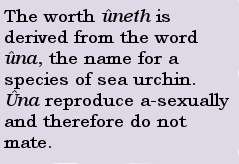
Lesson
1.2: Hard v. Soft and Accented v.
Non-Accented
Are the
following hard or soft sounds?
F S O j K
Please identify
which of the following letters represent accented hard sounds
a.
A c. j
b.
U d. E
LESSON TWO: GETTING COMFORTABLE WITH
TRANSLATION
A
Few Exceptions:
As with all languages, the above phonetic rules are not
perfectly consistent, and some words may not follow this or it may not always
be clear which letter to use ( A parallel in common language would be knowing
if "F" sound is spelled out with an F or a PH). Learning this will
come with familiarity, but here are some common guidelines to follow:
· use (Ë) instead of (U) when the sound
is at the end of a word.
· most often, (Y) is used instead of (I
or Ÿ) if you can
determine a word has evolved from archaic terminology
Nearly-silent vowels will often be
dropped in translation, as in bjaarn [BjaRN] (which is
technically pronounces BĴAAr.în). Typically,
either spelling is accepted (similarly to the different but equally correct
spellings color and colour)
Most often (J) will be used for
both the ‘zh’ and ‘y’ sounds instead of using (Ĵ), especially in printed text. In most
instances, if the J comes after a liquid or soft sound, it’s the ‘zh’ sound and
if it comes after a hard consonant, it’s the ‘y’ sound.
Hjem (h.ƷEM) vs
Bjaarn (BĴAAr.în)
Lesson
2.1: Phonetic Spelling
Write your
name how you spell it in common language, then next to it write out the phonetic
spelling using the orthography chart above.
Now that
you know the sounds that make up your name, Can you write it using the native
characters?
Vocab List 1: Because Who Doesn’t Love Animals?
To get familiar with distinguishing between hard
or soft, accented or non-accented letters, let’s look at the words for some of
the animals you may already be familiar with.
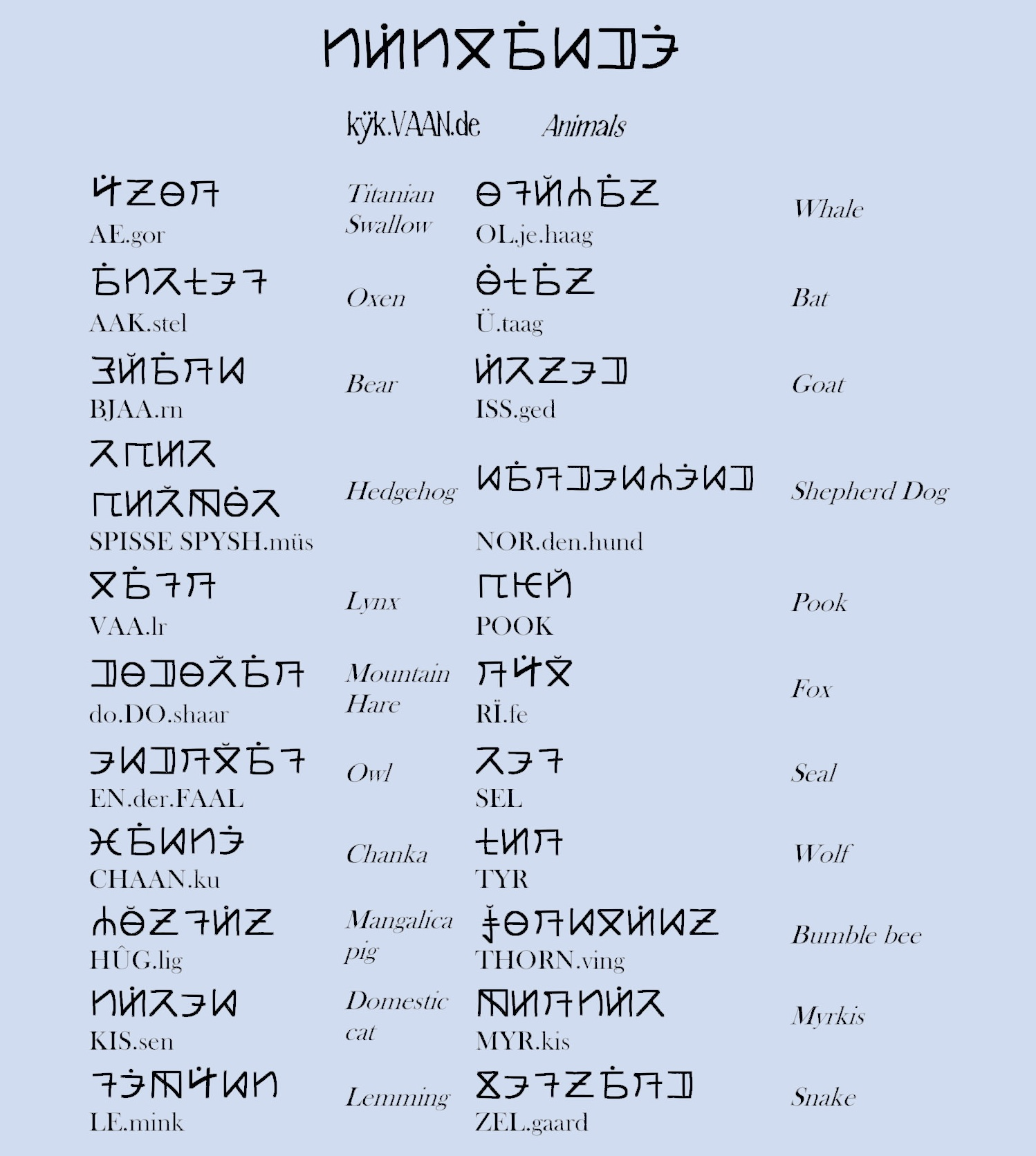
Use the chart above until you are familiar with
how to pronounce each word.
Lesson 2.2: Pronounciation
Can you
match together which 2 of these animals’ names rhyme the closest?
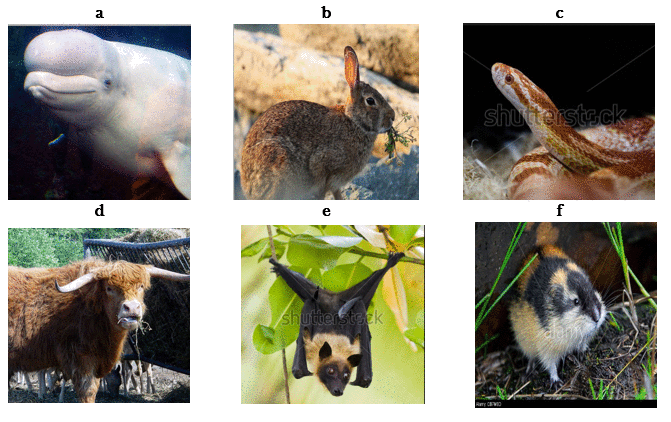
LESSON
THREE: WORD STRUCTURE
Syllabic
Structure:
Much like English, the nucleus of each syllable in Titanian
language is the vowel.
A I E o Y
As an example, let’s take the word GOlDAn (Gaaldan) meaning to sing.
It is comprised of two syllables, each containing the vowel A :
Gol.DAn GAAL.dan
(to sing)
The coda (the remaining part of the syllable) can be any
combination consonants. A new vowel usually indicates a new syllable.
If there are more than 2 consonants in the onset (the part of
the syllable before the vowel), one must be a liquid consonant [r, l] or [h]
DRoTYr DRO.htyr (knight )
It is not unheard of to have two stressed syllables in a row,
but it is very uncommon. Most examples of this are found in names and ancient
dialects.
Suffixes and Word Conjugation
As you will learn in future lessions, words can be modified
and gain new or nuanced meanings. There are a myriad of reasons for this, including
but not limited to: plurality, tense, and conjugations. Similar to the common
language, Titanian words are almost always modified by adding a suffix or
changing the end of the word.
An example of this can be seen when one wants to identify where
they were born. You could use the country name as the object of the sentence:
I am from Titania. TyTANje ti.TAN.jë
Or, you could change the phrasing so the country name is an
adjective.
I am Titanian. TyTANSET ti.TAN.set
The suffix -set
is added to the end of the root word Titania.
This is just one basic example. We will learn the details about such
conjugations in later lessons.
UNIT ONE REVIEW
The
following words are cognates, meaning the word shares the same linguistic
derivation and pronunciation in both the common language and in Titanian.
Please familiarize yourself with orthographic symbols as well as the characters
of the Titanian alphabet by filling out the chart below.
|
Common language
|
Titanian Translation
|
|
|
Orthographic
|
Native characters
|
|
Vibranni
|
vÿbraani
|
|
|
Gearford
|
|
|
|
|
chaankë
|
|
|
Fimbrian
|
|
fymbrYEn
|
|
|
skutlkovy
|
|
|
|
|
mOKn bOKn
|
Can you
write out the pronunciations of each of these words? Follow the form used to
indication pronunciations found throughout the unit.
UNIT TWO
LESSON FOUR: GRAMMAR AND SENTENCE STRUCTURE
Syntax – Verb-Second Order:
Conventionally, sentences are
written in verb-second order,
meaning the subject and object of the sentence (as well as any additional
clauses) can be placed in any order, as long as the verb holds the second
position of the sentence.
A good example of this can be seen in introductory phrases:
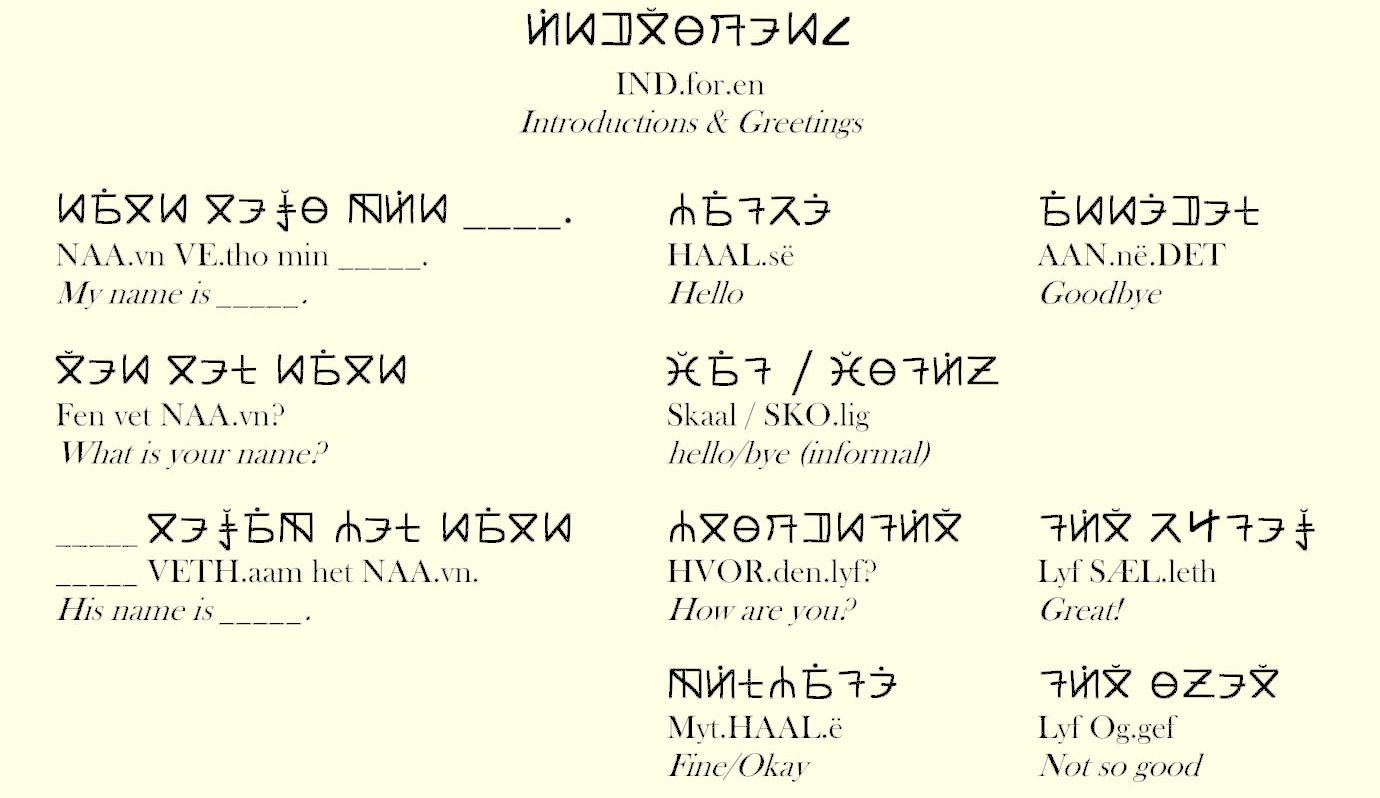
Examine the first two phrases
above. The verb vethaan (to be
called/named) is the second position in both sentences, though the subject, Min/Fen,
and the object, naavn, are in opposing orders.
Verb-second order is limited to
finite verbs. Infinitives (verbs in unconjugated form) and participles (a verb
used to modify a noun, such as ‘written’ in the sentence ‘Stephen King has
written many books’) do not have to follow this structure.
KySEN ET MET
HeND VEx
KÏS.sen et Met hund veth. (My dog is named ‘Kitten’).
The verb is in perfect tense, therefore the participle, ‘named’ can be
last in the sentence.
Lesson
4.1: Practicing Correct Syntax
Read the
following introductions and determine if the sentence structure is correct. If
it is incorrect, please write a correct version of the sentence below.
·
VExo MyN NOVN ASTRyD
___________________________________
·
NOVN VET fEN
___________________________________
·
HET VExOM NOVN SVEN
___________________________________
Punctuation
Now that you know how to ask someone their name and give a
response, it might be helpful to know how to indicate a interogative or
delcarative sentence as well as other basic punctuation marks.
The punctuation listed below essentially assume the same
functions as their equivalents in the common language.
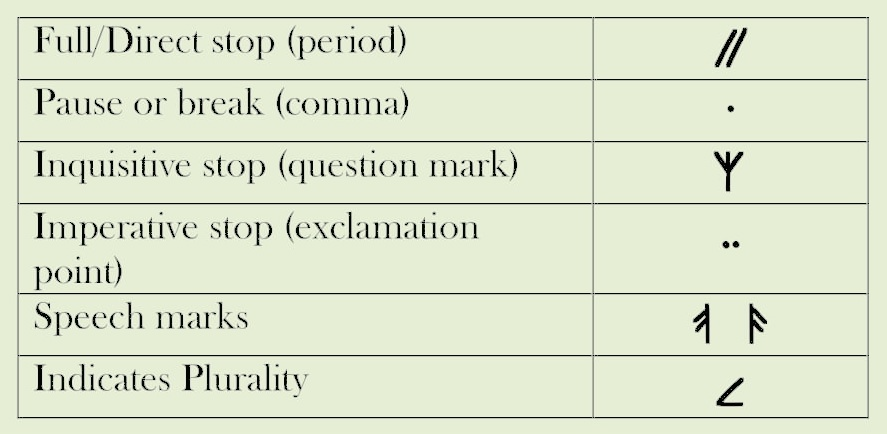
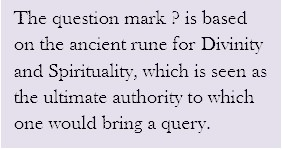
The question mark ? is based on the ancient rune for
Divinity and Spirituality, which is seen as the ultimate authority to which
one would bring a query.
|
The only one that may seem unfamiliar is the last symbol. The
closest equivalent would by the ‘s’ suffix added to nouns to make them plural.
The plurality symbol works the same way in Titanian. It modifies nouns to
indicate that there is several.
Singular: Cat KySEN
Plural: Cats KySEN<
Lesson
4.2: Punctuation
Can you
write ‘My name is ____. What is your name?’ using correct grammar and
punctuation? (Note: the quotation marks around the phrase are not part of the
phrase itself, but used to dictate what should be translated.)
LESSON
FIVE: TALKING ABOUT YOURSELF AND OTHERS
Personal
Pronouns
In order to properly conjugate verbs (as well as you
know…make sentences), you will need to know basic pronouns. These will allow
you to talk about both yourself and other people. Here are the six (eight if
you count each gender for third-person) personal pronouns:
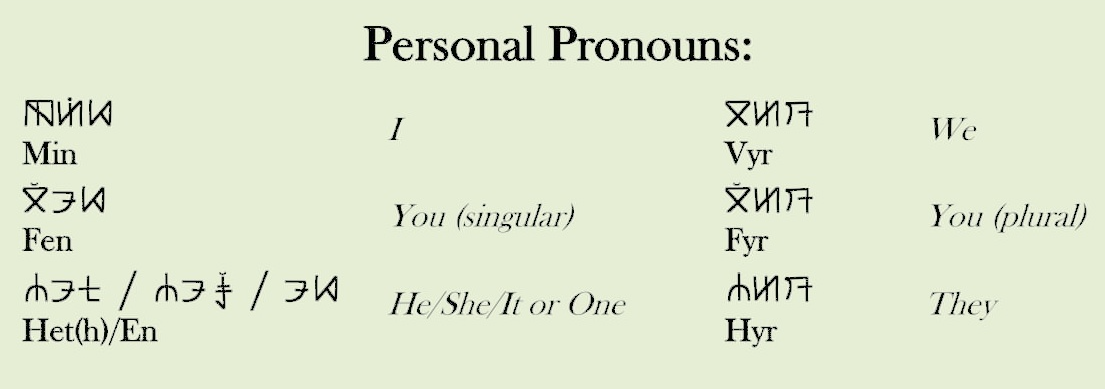
Some languages have different pronounces to address someone
directly depending on their status or relationship to you (i.e. a formal and
informal equivalent of ‘you’). Titanian does not distinguish between formal and
informal pronouns.
Imparative statements (phrases that give a command) will use
the conjugations for FYR, though usually the pronoun itself will be dropped.
Name him Erik. aRyK VExyS fet.
It should also be noted that the third-person pronouns are the
only ones that are gendered, and male and female pronouns are only used for
persons based on their preference and animals based on their sex. When speaking
about objects, locations, and other nouns use the gender-neutral EN.
Lesson
5.1: Identifying Pronouns
Identify the pronoun and the conjugated verb in the following sentences.
·
HOR ES MyN.
Haar es mïn. Pronoun:
___________
(I am tall.)
· FEN VYR LON.
Fen VYR laan Pronoun:
___________
(You speak a lot.)
·
HET RosEM LUOx.
Het RO.shem LÜ.aath Pronoun:
___________
(He runs quickly.)
Adjectives and Gendered Forms:
Adjectives are generally placed directly before or after the
noun which they modify, but technically it can be placed anywhere in the
sentence as long as the verb-second form is not contradicted. The following are all correct versions of the same sentence:
BRONDLyT EM FYR HUG.
Braandlyt em
fyr hüg.
FYR EM BRONDLyT
HUG.
Fyr em braandlyt hüg.
HUG EM FYR BRAANDLyT.
Hüg em Fyr braandlyt.
As a general rule, since nouns are not gendered, adjectives only
have one ("neutral") form. There is an exception to this, however,
when the adjective directly modifies a pronoun or proper noun, it can change
form based on the gender of said pronoun.
To clarify what is meant by this, let's look at an example in
the Common Language first:
- Orla is a good lawyer.
She wins almost every case.
The
adjective, good, in this instance directly modifies the
noun 'lawyer' not the proper noun 'Orla'. The adjective would be used in a
general(neutral) form
- Max is Paorrian, but
he is also Vibranni.
Here, both Paorrian and Vibranni directly
modify Max (or 'He' if replaced by pronoun.) These adjectives would change
to a masculine form.
The plural form of a
neutral adjective will have the plurality indicator at the end, however there
is no plural feminine or plural masculine.
The neutral form of an adjective is often called the general
form or standard form, since it is
the default form of an adjective which is can be used in a general case (see
example above).
Lesson 5.2: Gendered
v. Standard Adjectives
Would the following adjectives (in standard form in brackets) be
kept in standard form or be switched to a gendered form? If it should be
gendered, what is the correct form?
aRyK LyGo ASyVOL [
ToROfSyT ]. Standard Gendered
A.rik LI.ggo A.sti.VAAL [to.RAAF.sit].
(Erik lives in the dry desert.)
MyN ES [ HiLEN ]. Standard Gendered
Min es [HÎ.len].
(I am well)
HeND [ black ] ES [ SiLEN ] HeND. Standard Gendered
Hund [BLACK] es [SAEL.len] hund.
(The black dog is a good dog.)
Most gendered adjective
forms follow a pattern: the root (or in some cases, the entire word) is kept
and endings are added; -leth is added for feminine form and -lyt for
masculine form.
Vocab List 02 – Personal Identifier Adjectives
Let's practice with some
adjectives that follow this form. Letters in bold would be discarded in favor
of the endings discussed above. Adjectives without bold letters would just have
the endings added onto the original word.
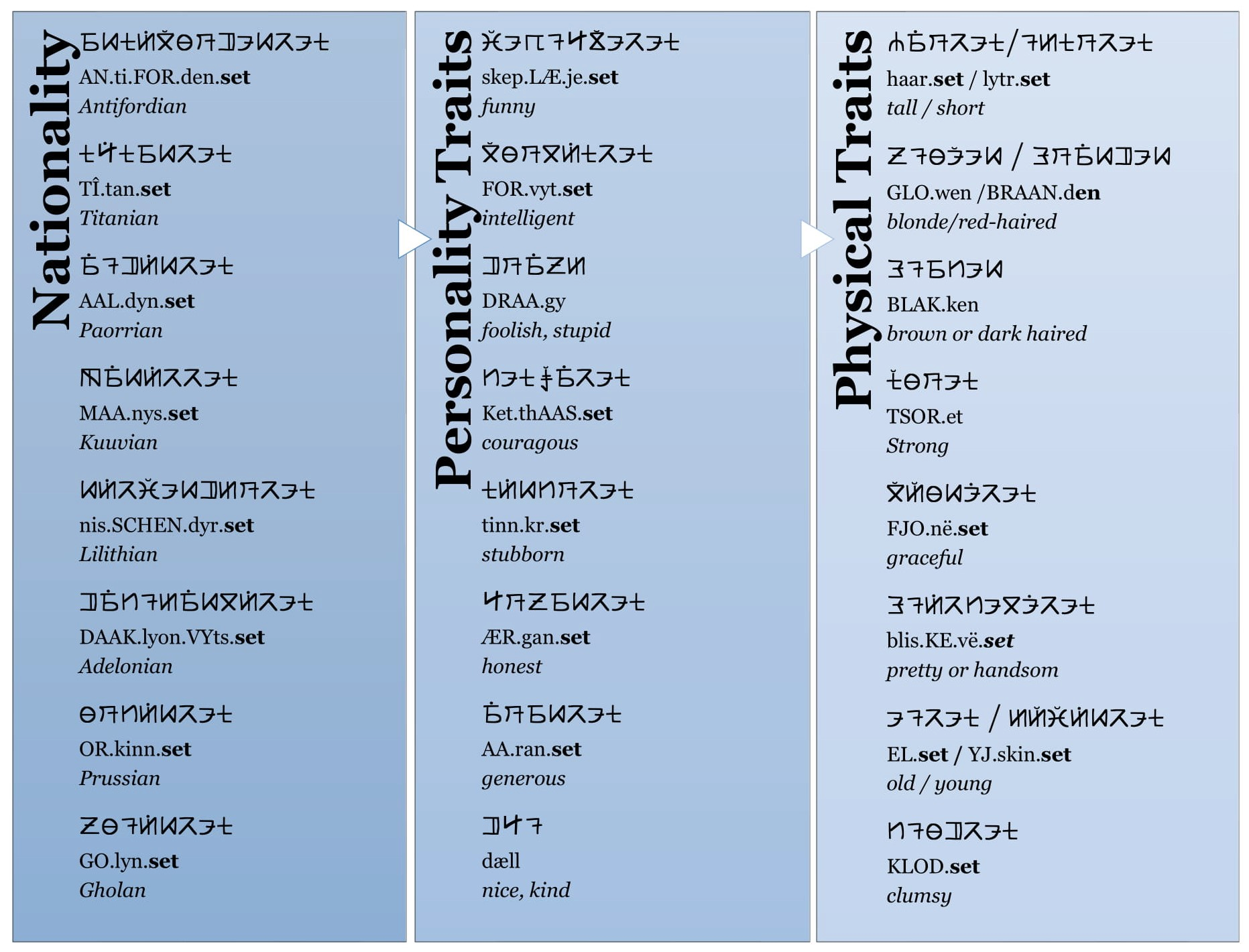
The names for
Lilithia and Adelon, the two countries that make up the island of
Manenlande, Nyschendyr (“Night
Beast” or “Moon beast”) and Daaklyjonvystr
(“One who hunts at dusk”) come from an archaic fairy tale about the origin
of separate nations.
|
Some words have the ending of the word in bold. These will change when in
a gendered form. Some adjectives, dush as DIL and toRET will not change, regardless of the subject or object it is
modifying. You will be able to recognize the former by the suffix -SET (-set) in the
standard form of the word.

LESSON SIX: SIMPLE CONVERSATION
Complete Sentences
We know how to use pronouns and how to modify adjectives for
them respectively. Now, let’s start to form some complete sentences. To do
this, we must first learn to conjugate a few verbs. Conjugation will be covered
in detail in the next unit, however we will learn the different forms of two
verbs that will be useful with the vocabularly learned so far: VExAN (to be called/named) and EsM (to be).
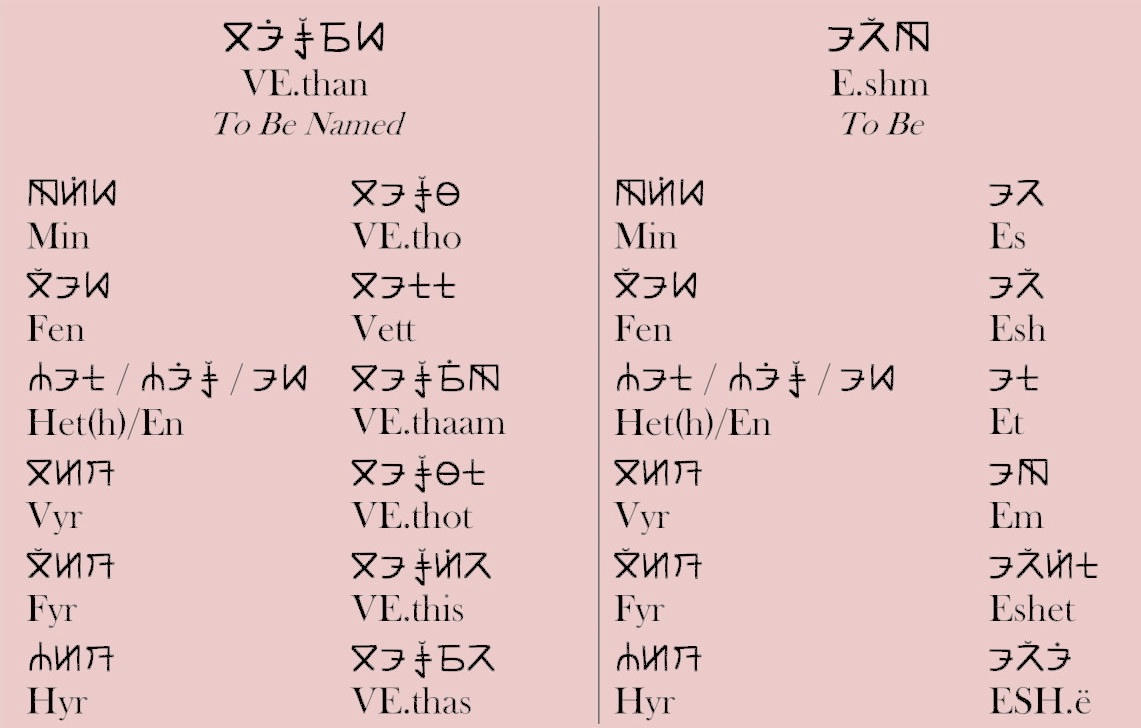
Lesson 6.1: Reading Complete Sentences
Please
translate the following sentence. Use all of the information you’ve learned in
this and the previous unit to assit you.
MyN VExo BoRyK. TiTANLyT ES MyN.
Min vetho Boric. Tîtanlyt es min.
_____________________________________________________
NOVN VETT VEN?
Navn vett fen?
__________________________________
UNIT
TWO REVIEW:
Read the
following sentences and answer the questions that follow. For this excersize it
might be helpful for you to know (YES) and (NO).
1.
ySGED et KLoDLEx. SITAN
ET HEx NOVN.
Who is being described:
Do you know their name?
2.
FYR EsET GLoWEN.
True or False: The subject(s) of this
sentence is(are) tall.
3.
oRKyNLyT ET VON KRESR.
Where is the subject from?
Is the subject masculine or feminine?
4.
goL VExo MyN NOVN. MyN ES BRycENLyT.
What can you tell me about the
subject?
5.
VYR EM IRGANSET<
True or False: We are nice.
Fill in the
blanks for this conversation.
- HOLSe
-
- HVoRDN
LyF?
-
- LyF SILEx. OrxR
VExo MyN. FEN VET NOVN?
-
- MONySET Es FEN?
-
- coLyG
-














